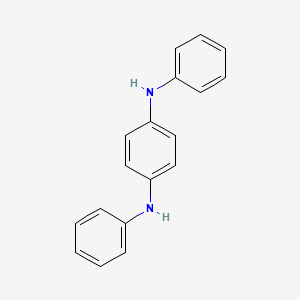D0426 | DPPD
| Toxicity | Dose | Time | Species | Model | Method | Action | Positive criterion | Reference |
|---|---|---|---|---|---|---|---|---|
| DEPOLARIZATION | 1 μmol/L | 3 minutes | rat | liver mitochondria | Assessment of Mitochondrial Membrane Potential; coincubated with diclofenac | decrease | p < 0.05 | 6 |
| ACCUMULATION OF CALCIUM | 1 μmol/L | 2 minutes | rat | liver mitochondria | Assessment of Mitochondrial Ca2+ Efflux; Incubated in the presence of Diclofenac(50 μmol/L); Energized with succinate | Negative | not mentioned | 6 |
| Pictogram | Signal | Statements | Precautionary Statement Codes |
|---|---|---|---|
 |
Warning |
H317: May cause an allergic skin reaction [Warning Sensitization, Skin] H412: Harmful to aquatic life with long lasting effects [Hazardous to the aquatic environment, long-term hazard] |
P261, P272, P273, P280, P302+P352, P321, P333+P313, P363, and P501; (The corresponding statement to each P-code can be found at the GHS Classification page.) |
   |
Warning |
Aggregated GHS information provided by 310 companies from 6 notifications to the ECHA C&L Inventory. Each notification may be associated with multiple companies. H317 (100%): May cause an allergic skin reaction [Warning Sensitization, Skin] H341 (28.71%): Suspected of causing genetic defects [Warning Germ cell mutagenicity] H361 (28.71%): Suspected of damaging fertility or the unborn child [Warning Reproductive toxicity] H400 (28.71%): Very toxic to aquatic life [Warning Hazardous to the aquatic environment, acute hazard] H410 (24.84%): Very toxic to aquatic life with long lasting effects [Warning Hazardous to the aquatic environment, long-term hazard] H412 (75.16%): Harmful to aquatic life with long lasting effects [Hazardous to the aquatic environment, long-term hazard] Information may vary between notifications depending on impurities, additives, and other factors. The percentage value in parenthesis indicates the notified classification ratio from companies that provide hazard codes. Only hazard codes with percentage values above 10% are shown. |
P201, P202, P261, P272, P273, P280, P281, P302+P352, P308+P313, P321, P333+P313, P363, P391, P405, and P501; (The corresponding statement to each P-code can be found at the GHS Classification page.) |
 |
Warning |
H317: May cause an allergic skin reaction [Warning Sensitization, Skin] H412: Harmful to aquatic life with long lasting effects [Hazardous to the aquatic environment, long-term hazard] |
P261, P272, P273, P280, P302+P352, P321, P333+P313, P363, and P501; (The corresponding statement to each P-code can be found at the GHS Classification page.) |
 |
Warning |
H317: May cause an allergic skin reaction [Warning Sensitization, Skin] |
P261, P272, P280, P302+P352, P321, P333+P313, P363, and P501; (The corresponding statement to each P-code can be found at the GHS Classification page.) |
| 1,4-Benzenediamine, N,N'-diphenyl- | 1,4-Benzenediamine, N1,N4-diphenyl- | 1,4-Bis(phenylamino) benzene |
| 1,4-Bis(phenylamino)benzene | 1,4-Dianilinobenzene | 1-N,4-N-diphenylbenzene-1,4-diamine |
| 27137-31-1 | 4,4'-Diphenyl-p-phenylenediamine | 4-Phenylaminodiphenylamine |
| 74-31-7 | ACM27137311 | ACMC-1CNH0 |
| AI3-14323 | AK-73002 | AKOS015840677 |
| AM20060718 | ANW-36464 | AX8016845 |
| AgeRite DPPD | Altofane DIP | Antage DP |
| Antigene P | Antioxidant H | BR-73002 |
| BRN 2215944 | Benzenediamine, N,N'-diphenyl- | C-16255 |
| C14501 | C18H16N2 | CAS-74-31-7 |
| CC-31910 | CCRIS 3500 | CHEBI:34860 |
| CHEMBL1333512 | CTK8B2266 | D0609 |
| DB-055859 | DD517SCM92 | DDPD |
| DFFD | DPPD | DSSTox_CID_538 |
| DSSTox_GSID_20538 | DSSTox_RID_75647 | DTXSID9020538 |
| Diafen FF | Diphenyl PPD | Diphenyl-p-phenylenediamine |
| EINECS 200-806-4 | Ekaland DPPD | FT-0629584 |
| Flexamine G | HMS3039G07 | HSDB 2894 |
| JZF | KSC912E6N | LS-1630 |
| MFCD00003015 | MFCD00003015 (95%) | MLS002152909 |
| N,N inverted exclamation mark -Diphenyl-p-phenylenediamine | N,N' diphenyl-p-phenylene diamine | N,N'- Diphenyl-p-phenylenediamine |
| N,N'-Difenyl-p-fenylendiamin | N,N'-Difenyl-p-fenylendiamin [Czech] | N,N'-Diphenyl-1,4-diaminobenzene |
| N,N'-Diphenyl-1,4-phenylenediamine | N,N'-Diphenyl-4-phenylenediamine | N,N'-Diphenyl-p-phenylenediamine |
| N,N'-Diphenyl-p-phenylenediamine, 98% | N,N'-diphenyl-1,4-benzenediamine | N,N'-diphenyl-1,4-dia minobenzene |
| N,N'-diphenyl-1,4-phenylene diamine | N,N'-diphenyl-N,N'-p-phenylenediamine | N,N'-diphenylbenzene-1,4-diamine |
| N,N-Diphenyl-1,4-benzenediamine | N1, N4-diphenylbenzene-1,4-diamine | N1,N4-Diphenylbenzene-1,4-diamine |
| NCGC00090861-01 | NCGC00090861-02 | NCGC00090861-03 |
| NCGC00090861-04 | NCGC00257908-01 | NSC 5761 |
| NSC-5761 | NSC5761 | Naugard J |
| Nocrac DP | Nonflex H | Nonox DPPD |
| OR350284 | P-PHENYLENEDIAMINE, N,N'-DIPHENYL- | Permanax 18 |
| Permanax DPPD | Q-201436 | Q22829255 |
| S-1528 | SCHEMBL42930 | SMR001224513 |
| ST2413611 | ST50319401 | STR04517 |
| SY030281 | Stabilizer DPPD | TC-125209 |
| TRA-0205850 | Tox21_200354 | UNII-DD517SCM92 |
| UTGQNNCQYDRXCH-UHFFFAOYSA-N | Usaf gy-2 | V1478 |
| WLN: RMR DMR | ZINC388645 | n,n'-di-phenyl-p-phenylenediamine |
| n,n'-diphenyl-p-phenylendiamine | p-Bis(phenylamino)benzene | p-Phenylaminodiphenylamine |
| p-Phenylenediamine,N'-diphenyl- | phenyl[4-(phenylamino)phenyl]amine |
| DrugBank Name | N,N'-diphenyl-1,4-phenylenediamine |
| DrugBank | DB14192 |
| CAS Number | 13787-59-2, 27137-31-1, 74-31-7 |
| PubChem Compound | 6319 |
| KEGG Compound ID | C14501 |
| ChEBI | 34860 |
| ChemSpider | 6080 |
| Wikipedia | N,N′-Diphenyl-p-phenylendiamin |

